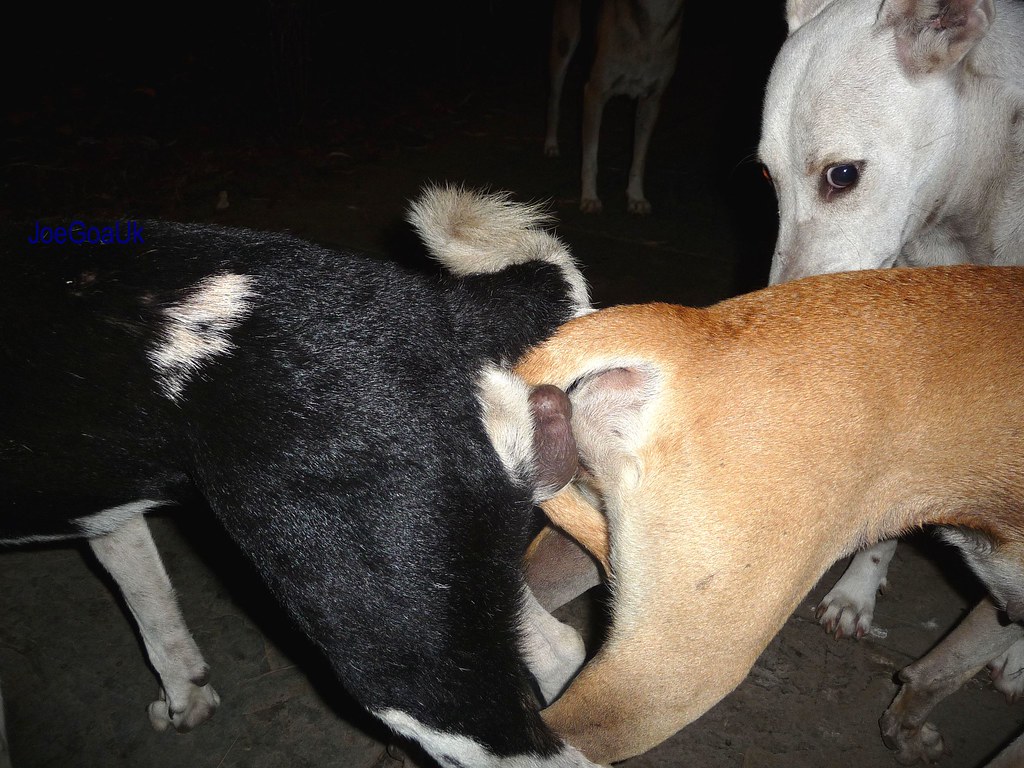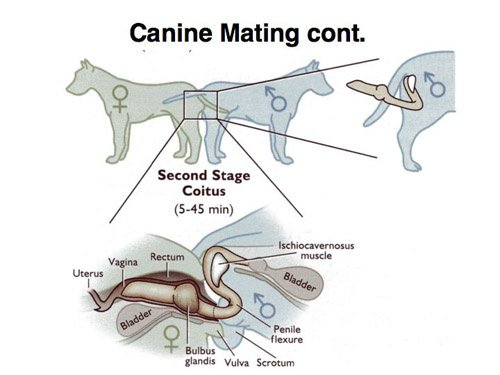After mating, a male dog may exhibit increased affection towards the female, and may also become more protective and territorial. This behavior is normal for a male dog as it is instinctual for them to guard the female after mating in order to protect her and their potential offspring.
When a male dog mates with a female, there are several behaviors and physical changes that can be expected. It’s important to understand these changes in order to provide proper care for the male dog and the female. From increased affection and protectiveness to potential anxiety and restlessness, knowing what to expect can help in handling the aftermath of mating.
Additionally, understanding the signs of pregnancy in the female can also be beneficial for planning and providing necessary support for the upcoming litter.

Credit: www.youtube.com
Physical Changes
When a male dog mates with a female, there are several physical changes that can occur. These changes are a natural part of the mating process and are important for understanding your dog’s reproductive health. Here are some physical changes you can expect to see after your male dog mates:
Swollen Genital Area
After mating, it is common for a male dog’s genital area to become swollen. This swelling is a result of increased blood flow to the area and is a normal reaction to the mating process. The swelling may last for a few days and should gradually subside as the body returns to its normal state. It’s important to monitor the swelling and ensure that it doesn’t become excessively red or painful, as this may indicate an infection or injury.
Enlarged Nipples
In addition to the swollen genital area, you may also notice that your male dog’s nipples become enlarged after mating. This is due to hormonal changes that occur during the mating process. The nipples may appear more prominent and may even become slightly sensitive. Like the swelling in the genital area, the enlargement of the nipples is temporary and should return to normal in a relatively short period of time.

Credit: www.flickr.com
Behavioral Changes
Behavioral changes in male dogs after mating are common and can impact their everyday habits. Understanding these changes can help pet owners provide appropriate care for their furry companions.
Increased Urination
Male dogs may exhibit increased urination following mating. This behavior is linked to marking their territory and is a natural response to mating activities. Pet owners should expect their male dogs to urinate more frequently in various locations. To address this, providing additional bathroom breaks may alleviate potential accidents indoors and help manage this behavioral change.
Possessiveness
After mating, male dogs may display possessive behavior. This can manifest through guarding of objects, toys, or even people. It is important for pet owners to recognize this change and implement measures to prevent any aggressive behavior. This can include training and socialization to establish clear boundaries and minimize possessiveness.
Appetite And Energy Level
After mating, male dogs may exhibit changes in their appetite and energy levels. It’s important to understand these changes to ensure the overall well-being of your pet.
Increased Appetite
Male dogs may experience an increase in appetite after mating due to the physical exertion involved in the process. This increase in appetite can be attributed to the energy expended and the body’s need for replenishment.
Temporary Fatigue
Temporary fatigue is a common occurrence in male dogs after mating. The mating process can be physically demanding and may lead to a temporary decrease in energy levels. It is essential to allow your dog ample time to rest and recuperate after this exertion.
Hormonal Changes
After mating, male dogs undergo various hormonal changes that can impact their behavior, mood, and overall well-being. Understanding these hormonal changes is essential for dog owners to ensure they can properly care for their male dogs during this time.
Elevated Testosterone Levels
One of the primary hormonal changes that occur in male dogs after mating is elevated testosterone levels. Testosterone is the hormone responsible for the development of male reproductive organs and secondary sexual characteristics, such as increased muscle mass and aggression. When a male dog mates, his body produces a surge of testosterone to prepare for the reproductive process.
This increase in testosterone levels can lead to various effects on a male dog’s body. It can result in heightened sexual drive, increased marking behavior, and even aggressive tendencies. Male dogs with elevated testosterone levels may display more dominant behavior, potentially posing challenges when interacting with other dogs or even humans.
Temporary Shift In Mood
Mating can also cause a temporary shift in a male dog’s mood. The hormonal changes that occur after mating can lead to fluctuating emotions, similar to how humans might experience mood swings. This temporary shift in mood can present itself in different ways, such as increased restlessness, irritability, or moodiness in male dogs.
During this time, it’s crucial for dog owners to provide their male dogs with plenty of mental stimulation and physical exercise to help alleviate any pent-up energy or frustration. Engaging in playtime, regular walks, or training sessions can be beneficial in keeping a male dog’s mood balanced and reducing any behavioral issues that may arise.
Overall, understanding the hormonal changes that occur in male dogs after mating is essential for dog owners. By knowing about the elevated testosterone levels and temporary shift in mood that can accompany mating, owners can better anticipate and manage their male dog’s behaviors and ensure their overall well-being during this time.
Potential Health Concerns
Mating is a natural part of a male dog’s life, but it’s important to be aware of the potential health concerns that can arise from the process. Understanding these risks can help you take proactive measures to ensure your dog’s well-being. Here are two notable health concerns to look out for:
Sti Transmission Risks
Just like humans, male dogs can also be at risk of sexually transmitted infections (STIs) during mating. These infections can be transmitted from an infected female to the male dog through genital contact.
Infections such as brucellosis and canine herpesvirus can lead to serious health problems, including infertility, abortion in females, and illness in both males and females. While the chances of transmission may vary, it’s crucial to be aware of these risks and take appropriate precautions.
Possible Injury During Mating
While mating is a natural behavior for dogs, it can sometimes lead to injuries. Male dogs may experience physical trauma during the mating process, especially if the female is uncooperative or aggressive. These injuries can range from mild scratches and bruises to more severe ones such as muscle strains or fractures.
It’s essential to closely supervise the mating process to ensure both dogs are safe and avoid any potential harm. If you notice any signs of discomfort or injury in your male dog after mating, consult with a veterinarian for a thorough examination and appropriate treatment.
By being aware of potential health concerns and taking appropriate measures, you can help keep your male dog safe and healthy during and after the mating process. Regular check-ups, safe practices, and a supportive veterinary team can play a vital role in ensuring your dog’s overall well-being.

Credit: www.wikihow.com
Frequently Asked Questions For What To Expect From A Male Dog After Mating
Why Do Male Dogs Sleep A Lot After Mating?
After mating, male dogs may sleep a lot due to the release of endorphins and the physical exertion involved in the mating process. This is a natural behavior and helps them recover their energy levels. It’s important to provide them with a quiet and comfortable space during this time.
How Long Does It Take For A Male Dog To Recover After Mating?
The recovery time for a male dog after mating varies, but it typically takes a few hours to a day. During this time, he may appear lethargic or low in energy. It’s important to monitor him closely and provide him with plenty of rest, water, and nutrition to aid in his recovery.
Can A Male Dog Become Aggressive After Mating?
It’s possible for a male dog to become more territorial or protective after mating due to the release of hormones. This behavior is instinctual and is aimed at guarding their mate and potential offspring. It’s crucial to provide a calm and controlled environment for the male dog during this time to prevent any potential aggression.
Conclusion
To sum up, understanding the changes in male dogs after mating is crucial for pet owners. From behavioral shifts to physical symptoms, being prepared will ensure a smooth experience. Keep an eye on your dog’s energy levels, appetite, and overall well-being.
Regular veterinary check-ups are also essential for maintaining your dog’s health. By being aware of what to expect, you can provide the necessary care and support to your furry friend during this crucial time.



